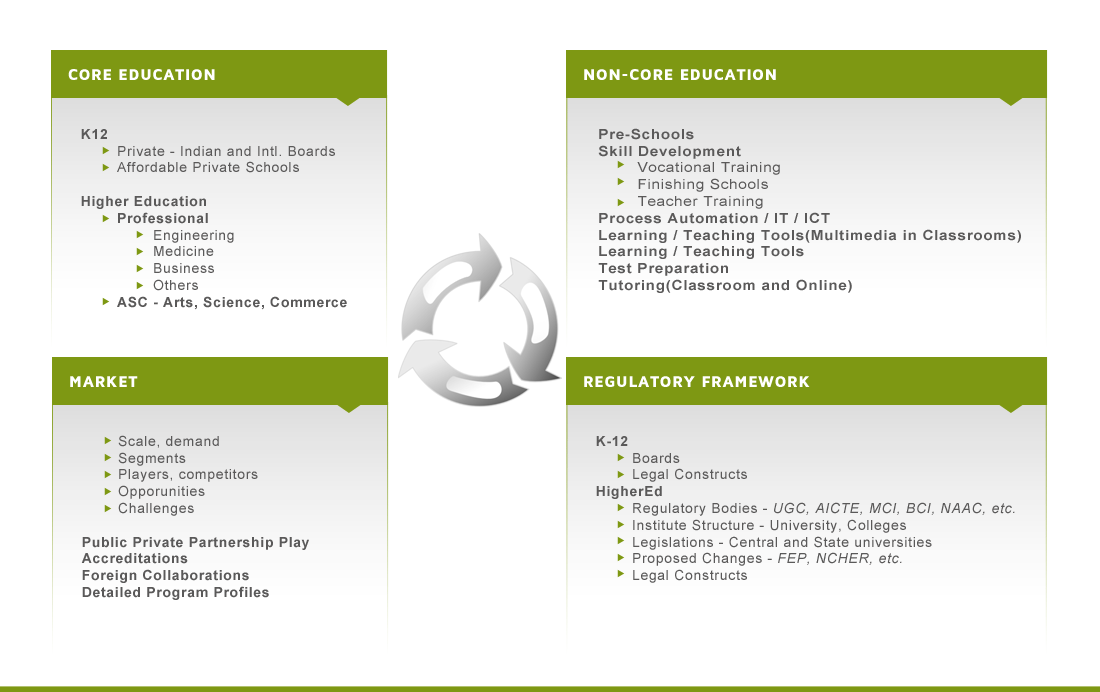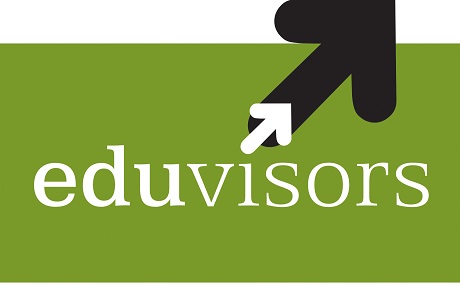Strategic Planning
The size, structure and growth of the education system in India are riddled with many contradictions. It is both large and small. In terms of absolute enrolment (over 37m students), it is the 3rd largest education system in the world, but in terms of gross enrolment ratio, it under 27%.
Universities and colleges together, there are more than 40,000 institutions. This is more than the number of colleges in the rest of the world put together! Yet., the number of degree granting institutions is just about 1000. The number of institutions is large, with very small average enrolment, resulting in a higher education landscape dotted with a large number of tiny institutions that are sub-optimal in size.
The government plans to expand enrolment to reach 35% GER by 2025. This would require additional 1000 universities. For this growth momentum to sustain, higher private investment in higher education seems like the only plausible option.
At the same time, the Education sector regulatory structure in India is multi-layered and complex – partly as a result of the federal structure of Indian state and partly a legacy of country’s colonial past. For example, there are multiple agencies and a complex web of rules and regulations that govern the higher education system with the UGC (University Grants Commission) at the helm. The Ministry of HRD is attempting, via various legislations, to change the regulatory structure. However, it is hard to achieve given various political constraints of the government and the sensitive nature of the changes proposed by the government. The state governments, the 13 professional councils at the national level and 5 professional councils at the state level, the state councils and affiliating universities are the key stakeholders in the education regulatory system.
In this quagmire of complex regulations and overwhelming demand, players in Education constantly need to explore opportunities and create sound plan against threats. Eduvisors’ wide range of strategic planning services and capabilities help the existing players and new entrants in Indian education develop long-term, robust, scenario-based strategies that help them navigate through these structural challenges. Our team has extensive experience helping organizations address all the key aspects of strategic planning for ventures in Education.
At Eduvisors we confront each challenge sans any preconceived notion; our solutions are based on facts rather than opinions.
IES - The Largest
Largest Capitalized Space
- Public spend of $30bn (3.7% of GDP)
- Private spend of $50bn (14% CAGR over FY08-12E)
Largest Demand
- 18,000 Higher Education Institutions (HEIs) ; largest globally
Largest Supply
- Globally the largest population of 572m within the 0-24 years age group.
Opportunities
‘Insufficient’ Funds
- Free product (govt. funded) loosign market share – 40% of the student base enrolled in private schools.
‘Insufficient’ Supply
- Only 0.85% of USD 30bn spent on capital expenditure
Lowest enrollments,Higher Dropouts
- Lowest GER globally at 9.97 (at higher education level)
The vast majority of Education leaders are currently changing their organization’s strategy, and half of them describe that change as ‘fundamental’. Such staggering numbers are reflective of today’s fast changing environment in the Indian education sector. Through clear objectives, a differentiated business model, innovative culture, technologies and relevant metrics – a few business leaders will make the right choices to achieve the growth they desire. We help your business to do just that. From strategy to execution, Eduvisors professionals work with you to translate strategy into action and results, through the following Strategic Planning efforts.
- Market analysis, which includes economic & political trends, industry & competitor factors and key value drivers.
- Potential scenario analysis, which explores a set of future market scenarios based on the anticipated market needs.
- Opportunity identification, which reveals new and attractive business opportunities for the future market.
- Strength analysis, which gives a good understanding of organization’s capabilities, market focus and positioning,.
- Strategy formulation, which provides a clear strategic direction for the future, taking into account market analysis, strength analysis, opportunity identification and future financial performance.
- Organizational alignment, which translates the developed strategy into action, providing a blueprint for execution.
- Financial planning and modelling, which predicts future financial performance of a given strategic direction, including the net present value and future shareholder value.
Our strategic planning exercise cover the complete spectrum of core and non-core segments in Indian education

Strategic planning assignments at Eduvisors are fully backed by strong market research, both qualitative and quantitative. The approach we deploy depends on the objectives of our clients. There is mix of science and art to choosing the right methodology or methodologies – to collect data from a variety of perspectives. Every data collection methodology has its strengths and limitations, and no one methodology fits in all situations. As a result, our market research projects often combine methods such as:
- In-depth management interviews;
- Focus groups discussions;
- Online surveys;
- Paper surveys; and
- Phone surveys.
To maximize the return on our clients’research-related investment, we start by identifying the most important stakeholders to survey. The constituencies we have surveyed include:
- Prospective students (Undergraduate, Graduate, Professional);
- Current students;
- Faculty, staff, trustees;
- Parents;
- Alumni;
- Regulators;
- Key opinion/thought leaders; and
- Guidance counsellors.
Client: A leading player in real estate focussed on residential market
Project Scope: Strategy and planning for a Greenfield venture in Education
Project Summary: Large infrastructure players in India are mandated to develop social infrastructure, such as K-12 and HigherEd facilities, as a part of large community developments. Our Client was mandated to develop 17 K-12 Schools and was planning to add 2 HigherEd institutions as a part of these multi-location communities. Eduvisors was engaged to evaluate opportunities for each location through a primary research led business planning exercise. A detailed research study followed by an investment plan for $210M over 7 years was the outcome. Following the planning exercise, Eduvisors has been engaged in a multi-year contract as implementation consultants.
Client: A leading player in roads, electricity and airport infrastructure development
Project Scope: Strategy and planning for the philanthropic initiative
Project Summary: The philanthropic arm of our client, a leading infrastructure player in India, engaged Eduvisors to work on a 20 year strategic plan for its social initiatives in affordable education, both in K-12 and HigherEd. The planning exercise evaluated all sub-segments and recommended K-12 and vocational skills initiatives for a total investment of over $80M over 20 years.
Do you have questions about how Eduvisors can help ? Send us an email and we’ll get in touch shortly.
